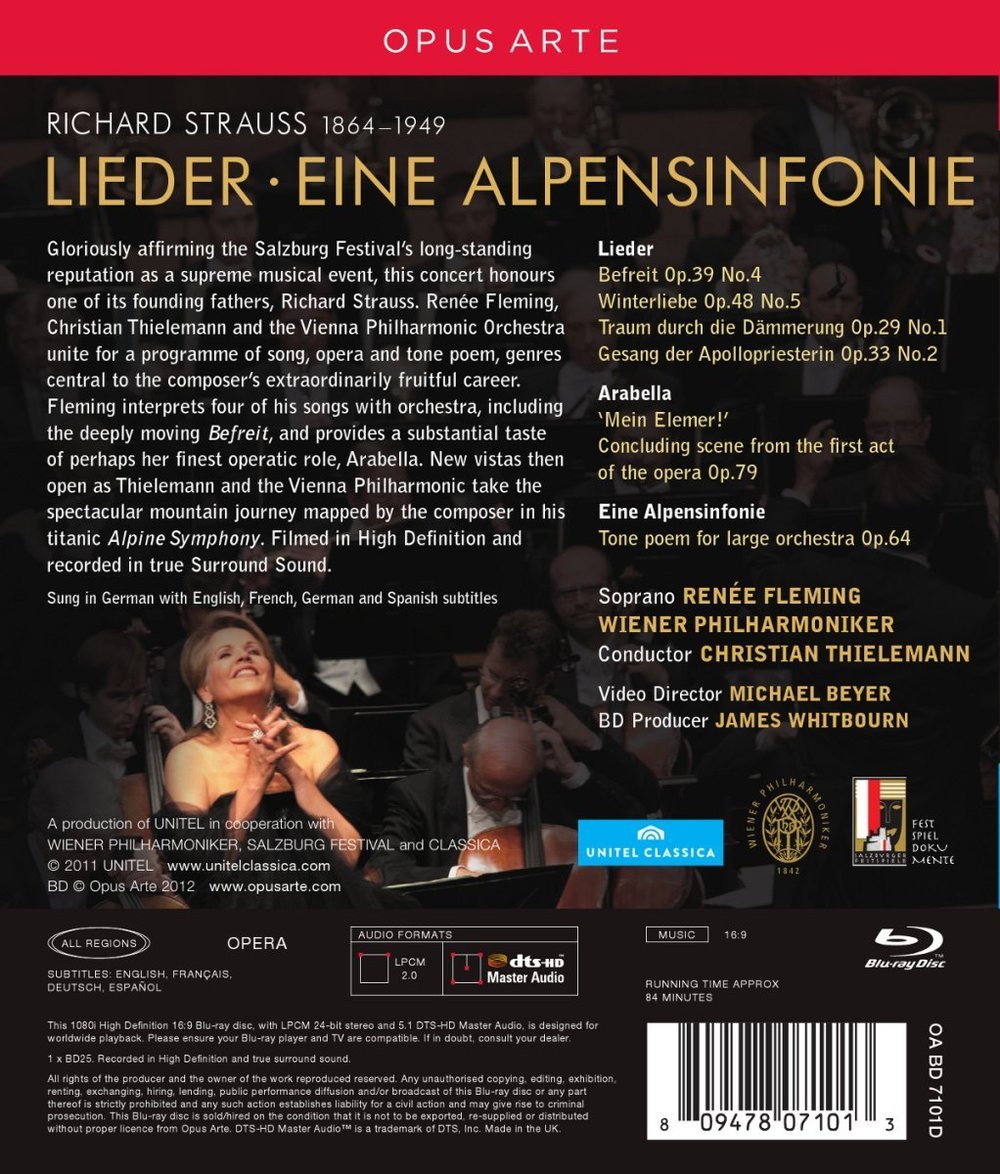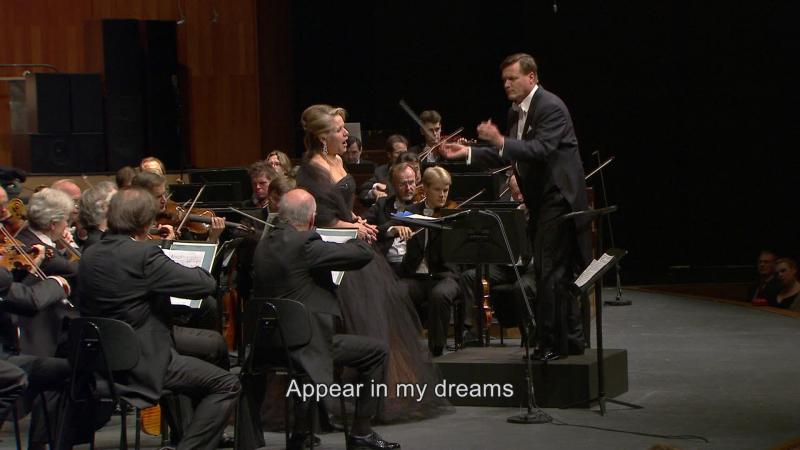

Richard Strauss: Renée Fleming In Concert. Christian Thielemann conducts the the Vienna Philharmonic in an all-Strauss program of 5 songs and a tone poem. Recorded 2011 at the Großes Festspielhaus as part of the Salzburg Festival. Here are the works performed:
"Befreit" ("Released") Renée Fleming, soprano
"Winterliebe" ("Winter Love") Fleming
"Traum durch die Dämmerung" ("Dream at Dusk") Fleming
"Gesang der Apollopriesterin" ("Song of the Priestess of Apollo") Fleming
"Mein Elemer!" ("My Elmer" from the opera Arabella) Fleming
Eine Alpensinfonie
Directed for TV by Michael Beyer; produced by James Whitbourn. Released 2012, disc has 5.1 dts-HD Master Audio sound. Grade: D+ blended overall grade
This all-Richard Strauss title came out in 2012, and we call it the "Fleming/Alpen video." It has a great opera singer, Thielemann, a Gramophone top-20 German orchestra, and Strauss songs for a warm up to a great tone poem. Later in 2015 a similar title came out that we call the "Harteros/Alpen video." It also has a great opera singer, Thielemann, a Gramophone top-20 German orchestra, and Strauss songs for a warm up to the same great tone poem. Wonk Bryan Balmer just published a detailed review of the Harteros/Alpen video in which he gave the soprano a good grade for the songs and the orchestra a bad grade for the tone poem. So now we jump in with a long-overdue review of the Fleming/Alpen video. And we also give our soprano a good grade and an even worse grade for the tone poem. In both recordings great work by the ladies is overshadowed by a tone poem video that's crippled with a dreadful case of that dastardly, obnoxious, grave disease we call DVDitis.
If you're going to read either of these reviews, you would want to read both. I'll link the two so you always can read them together.
If you started with this Fleming/Alpen review and you don't already know about DVDitis, you should go now to Balmer's Harteros/Alpen review. There you can bone up on DVDitis and the tools we use on this website to identify and fight the disease. Then you will be ready for the rest of this review.
Renée Fleming Singing Strauss Songs
Fleming warms up the crowd and the band with 5 nice songs that last 23 minutes (not counting the rests between songs). We did a Wonk Worksheet for these 23 minutes. We suggest you print out this WW and keep it handy. Look in the middle of the WW for the number 64 in a circle. This says that this short video has 64 realistic clips of Fleming singing. In the next 5 screenshots you see some of these 64 clips, all shot from different angles or ranges. In most of these shots you also see quite a lot about what the orchestra in doing:
Next below is a shot of Fleming that is not realistic since no audience member could see this. We also call this a conductor-over-backs shot. On the Wonk Worksheet, you see the designation "C/B" near the top—the form shows there are 9 conductor-over-backs shots during the 23 minutes Fleming sings. This is way too many of these low-value shots in such a short time:
If you study further the Wonk Worksheet for the Fleming songs, you can see there are 129 video clips during 23 minutes of singing. 129 divided into the total of 1380 seconds of music gives us the pace of 10.7 seconds per clip. This passes the pace test for DVDitis since a good HDVD should have a pace of 10 seconds or more. Now let's go back to again to those 64 realistic soloist shots. There are also 3 large-scale shots of orchestra players and 1 whole-orchestra shot. We call all these realistic soloist and large-scale views "supershots." By dividing the 68 supershots by the total of 129 clips, we see that 52% of all the clips are the kind of realistic and large-scale shots that we like. So the video passes the supershot test with crashing cymbals.
Finally, we look at the number of conductor shots: 17 + 9 = 26. By dividing 26 by 129, we see that 20% of the total clips showed the conductor. This is too many and the video flunks the conductor test.
But Fleming passes her tests. She gets rapturous praise from Ivan March in the September 2012 Gramophone (page 55), and Fred Cohn a pages 74-75 of the December 2012 Opera News says Fleming delivers "unstintingly" and "in her very best recent form."
Time for a grade. I start with an A+. I reduce to B+ for flunking the conductor test. Off to a decent start!
Eine Alpensinfonie
The print critics mentioned above also praise Thielemann and the Weiner Philharmonic for an excellent performance. This suggests the SQ is also fine. I have one reservation, however, about the miking and mixing as I could not hear the harps at any time, even with the video was focused on them.
Now lets look at the Wonk Worksheet for the Alpensinfonie. This form is more complicated because we now have a huge orchestra performing a famous Strauss tour-de-force tone poem. This piece has 394 separate video clips.
With HD cameras deployed to record this big work and orchestra, you would expect to see many glorious shots of the whole orchestra in action. Also, it's the duty of the videographer to show a whole-orchestra shot at the beginning of a piece so that viewers at home can see how the orchestra is organized. If the consumer doesn't know where the various instruments are located on the floor, he's hamstrung trying to make sense of the small-scale shots that are always shown frequently in symphonic music videos.
Well, as you see near the bottom of the Wonk Worksheet in the Whole-Orchestra section, there are only 3 WO shots. None of them appear near the beginning. And none of them actually shows all the players on the stage! We fudge a bit by calling a shot a whole-orchestra view if 80% or more of the players on stage are in it. The first WO shot to appear in the piece pops up almost 20 minutes into the work and is missing the second harp, the celesta, the organ, and several ranks of strings:
So the videogapher has miserably failed to show us decent views of the whole of this magnificent band. Here's a rundown of the shots the videographer delivers:
Conductor = 68
C/B = 41 (conductor over the backs of musicians)
solos, S§, SG, & misc. small-scale = 216 (small-scale shots that are needed for DVDs)
*L§, LG, & misc. large-scale = 16 (large-scale shots tend to look good only in HDVDs)
*PO = 13 (part-orchestra)
*WO = 3 (whole-orchestra)
IO = 37 (instrument only)
There's a total of 394 clips over 52 minutes of music, which yields a pace of 7.9 seconds per clip. Supershots (marked above with an *) amount to only 8% of the total clips, while conductor shots come in at 28%.
We have established the following rules-of-thumb to determine when a Blu-ray with star soloists is afflicted by DVDitis:
“A good symphony HDVD with star soloists should have a slow pace with more than 10 seconds per video clip on average. 20 to 40% of the clips should be large-scale "supershots." Total conductor shots should be less than 20% of the clips in the video.”
So this video badly flunks all the tests for DVDitis. Let's return to screenshots. The next view below, one of the few gorgeous treats in this segment, is a PO (part-orchestra) shot with all the 1st violins, cellos, basses, harps, and many of the winds. This shot appears only once:
Next below is a more typical and prosaic PO angle:
There are 216 shots of single players or small groups. I'll not bore you with any them except this view of the on-stage organ and the celesta (this is not a PO shot because the rest of the orchestra is so indistinct in the background):
Augmented everything:
A rare shot of part of the 1st violins:
Usually when you see something like the angle below, it's a C/B shot. But this time the videographer was interested in the 2nd violins. The camera should have zoomed in a bit before starting the shot. Then the conductor would not be competing for the viewer's attention:
This is a C/B shot. There are 41 of these no-to-low-value shots in a video of 52 minutes:
And as usual when the TV director goes so fast, there are many glaring errors such as this view of 4 horns with only one in good focus:
And next below is a jumbled shot:
Almost nothing in focus:
How did this next one below get past the editor?
And to conclude, a weird "peek-a-boo" angle:
Eine Alpensinfonie is not considered great music today because it's a mere description of a mildly interesting trek up and down a mountain. It's the opposite of the abstract music we revere as universal and profound. But this tone poem can still be hugely entertaining with vast forces on stage creating all kinds of unique musical events ranging from mass ensembles to rare instrumental voices. The audience must stay alert because anything can happen any time.
It would seem then that seeing the whole orchestra at work as much as possible would give the viewer the best opportunity to enjoy this piece. But this isn't possible in a DVD where the limited video resolution would make the large-scale approach unwatchable. So we wind up in the Blu-ray presentation getting led around by the video from place to place. The eye is dominant to the ear, and whatever the videographer shows us is what we hear. What see are isolated fragments of the orchestra and what we hear are also isolated fragments. The vast fabric of the alpine tapestry is shredded into rags.
Time for a grade. I start with A+. I take away the + for lack of 96kHz/24-bit sound. The video badly fails all 3 tests for DVDitis, which gets us me a D. There is no orientation WO shot, too many instrument-only shots, many careless video errors, and weak miking and mixing. All this points to a bad grade indeed, but who am I to say that a project by all these famous people and institutions deserves an F? I'll stop with D- for Eine Alpensinfonie. And for the overall title grade, I'll increase the mark to D+.
OR




















